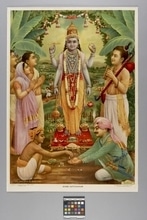Item number Eg352 from the MOA: University of British Columbia.
 Public
Public
Item Records
This page shows all the information we have about this item. Both the institution that physically holds this item, and RRN members have contributed the knowledge on this page. You’re looking at the item record provided by the holding institution. If you scroll further down the page, you’ll see the information from RRN members, and can share your own knowledge too.
The RRN processes the information it receives from each institution to make it more readable and easier to search. If you’re doing in-depth research on this item, be sure to take a look at the Data Source tab to see the information exactly as it was provided by the institution.
These records are easy to share because each has a unique web address. You can copy and paste the location from your browser’s address bar into an email, word document, or chat message to share this item with others.
- Data
- Data Source
This information was automatically generated from data provided by MOA: University of British Columbia. It has been standardized to aid in finding and grouping information within the RRN. Accuracy and meaning should be verified from the Data Source tab.
Description
Rectangular shaped print of grey blue-skinned, four-armed Vishnu standing on red cloth alter with offerings and surrounded by six worshippers, two seated on either side in front, one dressed in green coat. Four males wear white dhotis. One standing on right holds long, tubular, red-stringed instrument with peacock head ends, over his shoulder. In his left hand is a box inset with small cymbals. Female in front of worshippers on left wears a pink sari. Setting is green foliage landscape; large-leafed plant, one in each upper corner. Vishnu wears: orange floor-length dhoti, floral garlands and necklaces around neck, and a gold crown. He holds in each hand one object: mace, yellow disc, conch and flower. 'S.S. Brijbasi & Sons' plus address printed at base.
History Of Use
Indian popular religious prints have been published for nearly a century, first by German presses, later by Indian ones. The prints may take the form of calendars, posters, or simply images. The style of the representations is European. In the beginning they were Hindu images, but are now acquiring elements both of folk art and a romantic secularism. It is a living art currently influenced by the movie industry and non-Hindu religions. The images are a vehicle for advertising and are also used for religious purposes. This print was produced, framed, and displayed in a prayer room for 'puja' or worship.
Cultural Context
popular religious art
Item History
- Made in India during 1930
- Collected before 1982
- Owned by Stephen Inglis before January 1983
- Received from Stephen Inglis (Donor) during January 1983
What
- Name
- Identification Number
- Eg352
- Type of Item
- Overall
- height 71.2 cm, width 50.8 cm
Where
- Holding Institution
- MOA: University of British Columbia
- Made in
- India
Who
- Culture
- South India
- Previous Owner
- Stephen Inglis
- Received from
- Stephen Inglis (Donor)
When
- Creation Date
- during 1930
- Collection Date
- before 1982
- Ownership Date
- before January 1983
- Acquisition Date
- during January 1983
Other
- Item Classes
- works on paper
- Condition
- good
- Accession Number
- 0857/0200
Ask a question
Let the RRN community answer your questions
 Public
Public
With an account, you can ask other users a question about this item. Request an Account
Shared Knowledge
Share your knowlege of this item with the RRN community
 Public
Public
With an account, you can submit information about this item and have it visible to all users and institutions on the RRN. Request an Account









